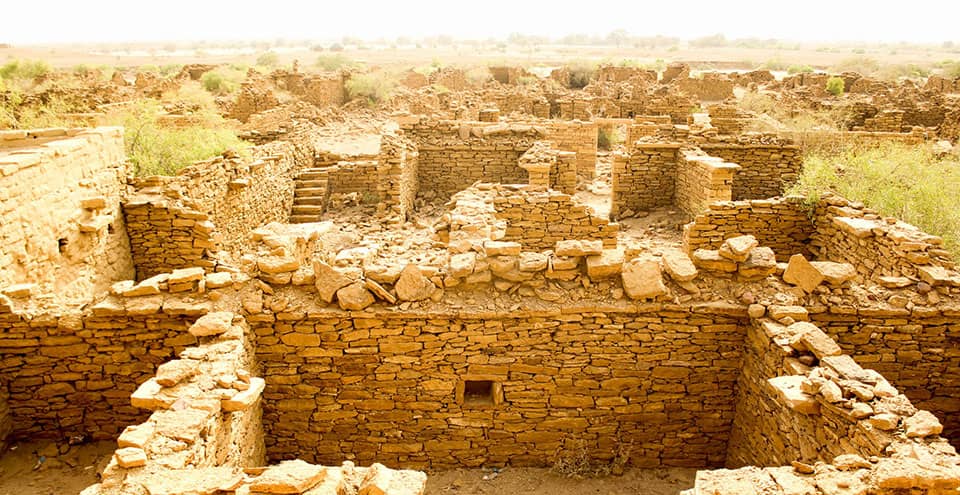
Kuldhara: The Enigmatic Ghost Village of Rajasthan
Kuldhara, a deserted village in the Jaisalmer district of Rajasthan, India, is a site steeped in mystery and history. Known for its eerie ambiance and historical significance, Kuldhara attracts travelers, historians, and curious visitors who are drawn to its ghostly charm and intriguing backstory. In this blog post, we’ll explore the history, key features, and visitor experience of Kuldhara.
Overview of Kuldhara
1. Location and Setting
Kuldhara is situated about 20 kilometers southwest of Jaisalmer, nestled in the Thar Desert. The village is set against a backdrop of golden sands and rugged terrain, which adds to its mysterious and haunting allure. The arid landscape and the remnants of the village create a surreal atmosphere that captivates visitors.
2. Historical Significance
Origins: Kuldhara was founded in the 13th century by the Paliwal Brahmins, a prosperous community of merchants and artisans. The village was once a thriving settlement known for its well-planned layout and advanced water management systems.
Mysterious Abandonment: The village was mysteriously abandoned overnight in the early 19th century. According to local legends and folklore, the villagers left due to a curse placed upon the village by a local ruler, though the exact reasons for the abandonment remain uncertain.
Key Features of Kuldhara
1. Architecture and Layout
Traditional Rajasthani Architecture: The village features traditional Rajasthani architecture with intricately carved sandstone havelis (mansions), temples, and wells. The use of sandstone gives the structures a distinctive golden hue, blending seamlessly with the desert surroundings.
Urban Planning: Kuldhara is known for its well-planned layout, with a grid-like arrangement of streets and lanes. The village was equipped with advanced water management systems, including step-wells (baoris) and tanks, to cope with the arid climate.
Temples and Buildings: The village is home to several temples dedicated to various deities, as well as communal buildings and residential havelis. The architectural style and craftsmanship reflect the prosperity and artistic achievements of the Paliwal community.
2. Ghost Village Mystique
Legends and Curses: The most famous legend associated with Kuldhara is that it was abandoned overnight due to a curse placed by a local ruler who fell in love with a beautiful girl from the village. According to the legend, the villagers left to avoid the ruler’s advances, and the curse prevented anyone from resettling the village.
Eerie Atmosphere: The abandoned state of Kuldhara, combined with its desolate desert surroundings, creates an eerie atmosphere. The empty streets and crumbling buildings evoke a sense of ghostliness, contributing to the village’s reputation as a “ghost village.”
3. Archaeological and Historical Research
Preservation Efforts: Efforts have been made to preserve the ruins of Kuldhara as a historical site. Archaeological surveys and research have been conducted to understand the village’s history and architecture better.
Tourism: Kuldhara has become a popular tourist destination, attracting visitors interested in history, architecture, and the supernatural. Guided tours are available to provide insights into the village’s history and legends.
Visiting Kuldhara
1. Accessibility
Travel: Kuldhara is easily accessible from Jaisalmer, which is well-connected by road, rail, and air. The village can be reached by hiring a local taxi or joining a guided tour from Jaisalmer.
Local Transportation: Within Jaisalmer, local transportation options include taxis, auto-rickshaws, and organized tour vehicles. The drive to Kuldhara offers scenic views of the desert landscape.
2. Visiting Tips
Respect Local Customs: Although Kuldhara is a deserted village, it is important to respect the local customs and the historical significance of the site. Avoid vandalism and be mindful of the preservation efforts.
Photography: Photography is generally allowed, but it’s advisable to check for any specific restrictions, especially regarding the interiors of temples and buildings.
Climate Considerations: Rajasthan’s desert climate can be extremely hot, especially during the summer months. The best time to visit Kuldhara is from October to March, when the weather is cooler and more comfortable for exploring.
3. Best Time to Visit
Season: The ideal time to visit Kuldhara is during the cooler months from October to March. This period offers pleasant weather for outdoor activities and exploration.
Avoiding Heat: The summer months (April to June) can be extremely hot, so visiting during the cooler season will make for a more enjoyable experience.
